Locomotives -
Operational Locos -
Locos under overhaul -
Locos on static display -
Locos formerly based on the Bluebell
Loco Roster -
Loco Stock List -
Loco Works News -
Join the Loco Dept


London Brighton & South Coast Railway
A1X Stroudley Terrier 0-6-0T
55 "Stepney" - built in 1875
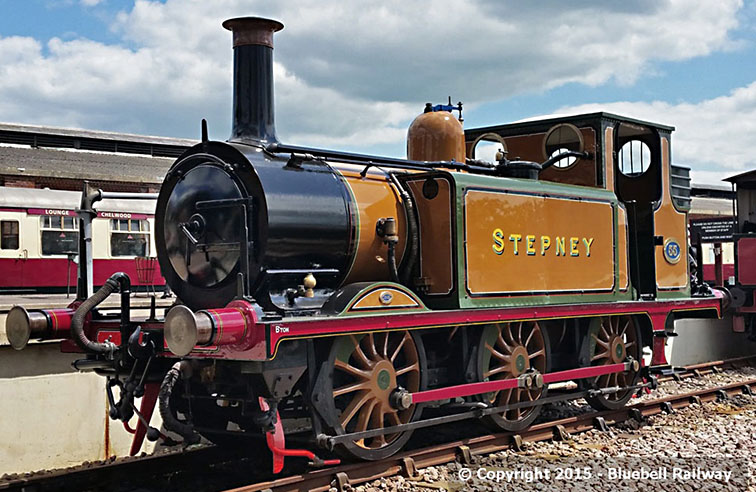
'Stepney' repainted back to LBSCR colours (Martin Lawrence - 7 June 2015)
Stroudley's famous Terriers * survived for decades after more modern designs had been scrapped, working on lightly laid Branch lines. Here these diminutive engines were often the only engines light enough to cross some particular bridge. In later years "Stepney" was particularly associated with the Hayling Island branch, until sold to the Bluebell Railway in May 1960 as our first locomotive.
Repainted into Stroudley's famous "Improved Engine Green" gamboge livery, seen above, it has been a favourite of many children, and some of those children are now introducing their own children to "Stepney the Bluebell Engine". In spite of its fame, "Stepney" has spent considerable periods out of traffic in its forty years on the Bluebell, but its popularity always causes it to bounce back to the top of the railway's priorities.
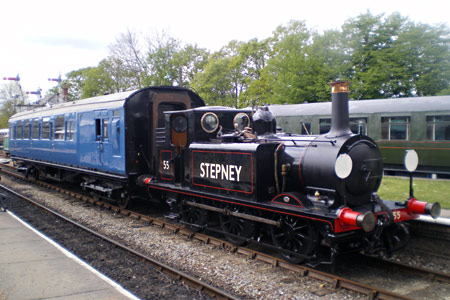 In 2010 a rapid overhaul of "Stepney" saw it back in steam for the 50th Anniversary of hauling its first train on the Bluebell in May 1960. It was repainted into the black (lined with red) livery it carried 55 years ago in the Bluebell Railway's first season (as seen in Richard Clark's photo on the left). Stepney then remained available for limited service until its main steam pipe failed in early 2014, and has now been repainted again into its traditional Stroudley Golden Ochre. At its next major overhaul it will require new cylinders, the castings for which have instead been used on "Sutton" at Tunbridge Wells, significant work on the frames and major boiler work.
In 2010 a rapid overhaul of "Stepney" saw it back in steam for the 50th Anniversary of hauling its first train on the Bluebell in May 1960. It was repainted into the black (lined with red) livery it carried 55 years ago in the Bluebell Railway's first season (as seen in Richard Clark's photo on the left). Stepney then remained available for limited service until its main steam pipe failed in early 2014, and has now been repainted again into its traditional Stroudley Golden Ochre. At its next major overhaul it will require new cylinders, the castings for which have instead been used on "Sutton" at Tunbridge Wells, significant work on the frames and major boiler work.
Our Children's Club, The Stepney Club is for children up to 8 years old.
Other Pictures:
Stepney in the 1960s.
Stepney in 1909
See also Derek Hayward's photos of 'Stepney' in Bluebell black, in Stroudley Livery and under overhaul in 2010.
We also have another Terrier on the Bluebell: No. 72 'Fenchurch'.
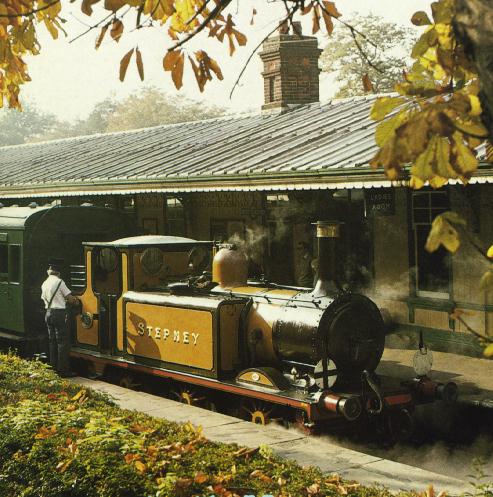
Class: A1X
Wheels: 0-6-0T
Class Introduced: 1872
Designer: William Stroudley
Total number built: 50 (10 still survive)
Built: 1875, Brighton Works, as Class A1
Rebuilt: to class A1X, 1912
Name: "Stepney"
Numbers carried: 55, 655, B655, 2655, 32655
Arrived on Bluebell Railway: 17 May 1960
Length: 26ft 1/2 in
Weight: 28 Tons 5 cwt
Water capacity: 500 Gallons
Coal capacity: 18cwt (approx.)
Boiler Pressure: 150 lb/sq.in
Driving Wheels: 4ft diameter
Cylinders: (2, inside) 12" x 20"
Tractive Effort: 7,650 lbs
Engine Brake: Vacuum
BR power classification: 0P
Right: 'Stepney' in its original Stroudley livery, at Horsted Keynes in the 1980s. (Mike Esau)
Below: 'Stepney' in Lindfield Wood with two Victorian carriages in 2007, and with 75027 when running as "Stepney the Bluebell Engine" for a 2006 Thomas-themed event (both Derek Hayward).
Note: * The Terrier nickname dates from their very earliest days, and was mentioned in an article about the locomotives in The Engineer of 17 January 1873 which states "and now William Stroudley has come forward with a still lighter class of engines, so small, so wiry, and so lively, that they have already been christened 'The Terriers'."
They were also known in later years as Rooters.
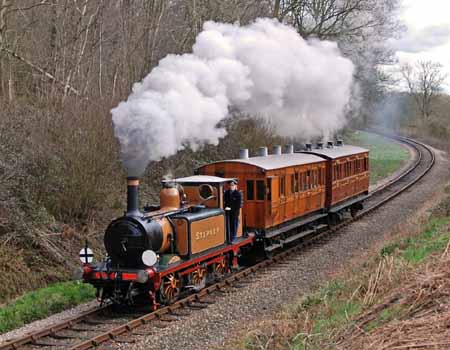
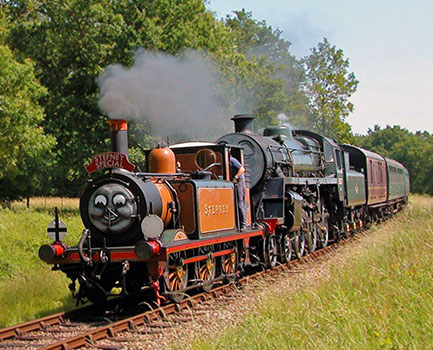
Stepney's History
The following article has been prepared by Graham Townsend, with the assistance of Mike Watts. Further information about Stepney's part in the Terrier story is provided (in italics) by Richard Salmon, taken from the Bluebell Railway's 1982 monograph "I'm Stepney".
The first batch of Terriers were started in 1872, and the building program lasted until 1880. So they first started running in 1872, and some are still running today, over a century and a quarter later. You are possibly not really concerned about current locations, nor probably even about 1872 locations, but the latter has a lot of bearing on the reasons for their being built in the first place.
When Stroudley came to office on the LBSCR in the beginning of 1870, he found a situation where there was very little in the way of standardisation among the loco stock of the LBSCR. Indeed the assortment of locomotives were by no means a match for the work that they had to do. He perceived the need for a small range of standard locos and in the following 15 years produced such a range, some 8 or so standard loco classes. This approach was very forward looking for the time and pre-dated similar concepts on the GWR by some 30 years, and Bulleid's concept by some 70 years. The class A, 'Terriers', were the smallest in the range, and were intended to be used for lightweight, block trains, particularly in the south London area, where the trackwork was of light construction, with poor foundation. The 'Terriers' were built as an integral part of the whole, the block train, trains of 5, 7 or even 9, similar 4-wheel coaches, permanently coupled. They (the coaches) had no intermediate buffers, or conventional draw hooks, but used close coupling bars between coaches. The main purpose of these trains was to work suburban traffic over the South London line between Victoria and London Bridge stations. Tightly timed lightweight trains, good acceleration was required between the frequent stops. The 'Terriers' were built with a 140lb pressure boiler and 13 X 20 inch cylinders. Most were later rebuilt with slightly larger boilers (at 150lb) without in any way spoiling their appearance.
The 'Terrier' was so successful, compared with the heterogeneous collection of Craven locos running on the LBSCR, that more were built than were actually needed for the London area. So their migration to the country parts of the LBSCR started.
As time passed, and we move to the 1880s and 1890s, the trackwork in the London area became much improved, and the suburban traffic became much heavier. Soon more powerful locos were needed for these trains, and this need was ably filled by another of Stroudley's standards, the D class 0-4-2T. The dispersal of the 'Terriers' was made to most outlying sheds on the LBSCR, as most of them had locals services of the kind that suited the small 'Terrier' well.
'Stepney' itself was built in December 1875, as one of a batch of fourteen Terriers to be based at New Cross shed to work over the East London line to Shoreditch. A higher profile working for one of these Terriers was the London Bridge portion of the Newhaven Boat train as far as East Croydon, loading to just 3 coaches and a couple of vans, speeds of 60mph were achieved down Forest Hill bank. Having received new larger (14-inch diameter) cylinders over the winter of 1893/4, losing its condensing pipes at that time, and then re-numbered 655 in 1901, it continued to work in London until March 1903, and following an overhaul, in May 1904 became one of four Terriers based at Brighton, working the Kemp Town branch and acting as Station pilot.
In total 50 Terriers had been built, but by the end of the century (the 19th!), the need for so many had been reduced. Not only that, but after 30 years of intensive working, many of these small engines were literally worn out, and a large proportion were scrapped in the first few years of the 20th century (11 in 1901-1904) and several sold off.
It was proposed to scrap the rest, but with the introduction of 'motor-trains' (push-pull to some ears), the 'Terriers' were found to be useful (as also were many D1 0-4-2Ts). For this use, new boilers were fitted, and other modifications carried out including often reducing the cylinder diameter to 12 inches, and so the 'Terrier' became an A1X. Many had been sold to private industrial users and other railways over the previous 10 years or so, and continued to be so. This included 2 to the LSWR for use on the Lyme Regis branch, to the SECR (the much-wandered 'Waddon', now displayed at the Canadian Railway Museum in Montreal), and to lesser lines.
'Stepney' had a more involved history than most in terms of fitment with Pull-push gear to operate motor-trains. Fitted with the LB&SCR mechanical control gear in 1907 (to work with the "Balloon" trailers), at this point the cylinders were sleeved down to 12-inch diameter and it was painted in the Marsh-era umber livery, loosing its name, and gaining a higher-pitched whistle. A return to London in 1911 saw 655 again working out of New Cross shed, kept busy on motor train duties between Tulse Hill, Tooting, Merton and Wimbledon, before moving the following year to West Croydon for services via Wallington to Belmont.
On conversion to A1X in 1912 it was then fitted for the new LB&SCR air-controlled motor-train system. A rejuvenated 655 (still known to the staff as 'Stepney') moved back to West Croydon and then Coulsdon North where duties included running trains to Crystal Palace.
Then in 1920 'Stepney' became the last of five Terriers to be loaned to the Woolmer Instructional Millitary Railway, operating trains between Bordon and Longmoor. Returning to the LB&SCR later that year 'Stepney' began its long association with Fratton shed to work the Hayling Island branch.
Over time, the numbers dwindled through scrapping, but the Southern in 1923 inherited a still-substantial number. By then, their use had almost exclusively been on branch lines on the Brighton section, and on SR-acquired branch lines on the IOW, and to use as shed pilots at some of the bigger sheds. The Southern put them to use on some ex-SECR branches, but continued with the slow withdrawal campaign (eg No.42 'Tulse Hill' in 1925). In the latter withdrawal phase, the much beloved 'Stepney' was also withdrawn, but escaped the axe to be resuscitated for the Hayling Island branch, and subsequent life on the Bluebell.
Withdrawn in 1925 and stored in Preston Park Paint Shop, in January 1927 'Stepney' emerged from Brighton Works in Southern Railway olive green as B655 (Brighton locomotives initially receiving a "B" prefix to their earlier numbers), and fitted with Vacuum brake and LSWR-type pull and push gear to work the Lee-on-Solent branch. Although the SR decided to standardise on the LB&SCR system in 1928, 'Stepney' still retained the LSWR gear in 1933 when re-numbered 2655, even though the Lee-on-Solent branch had closed to passenger services in 1930.
1938 saw 2655 say goodbye to the group of seven Terriers then based at Fratton, to be hired to the independent Kent & East Sussex Railway for the hop-picking traffic. By October 1939 Stepney was due an overhaul, which it received at Eastleigh Works, being out-shopped (on its 64th birthday, 21 December 1939) painted green but now with Bulleid-style lettering (before black became the wartime norm.) For the next few years it alternated between working at Fratton and the K&ESR.
Where would the future generations of train-lovers be without 'Stepney'?
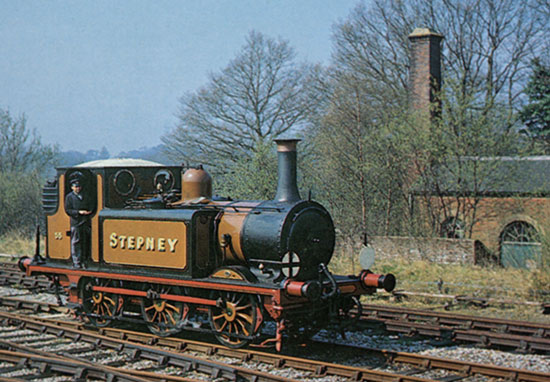
Although BR inherited substantial numbers of 'Terriers' in 1948 for use on the IOW, KESR, Hayling Island branch, Brighton Works, Littlehampton wharf, and even on the GWR line at Weston , near Bristol, their days were numbered, as traffic on these lines dropped off with the spread of the motor car.
'Stepney' itself returned to Brighton Works in December 1949 to emerge in lined black livery with "British Railways" on the tank sides, employed again on the Hayling Island services until a return to Rolvenden shed on the now nationalised K&ESR in 1953, including a Hop-pickers Special service worked with 32636 (formerly, and now again, known as 'Fenchurch'). On the night of 2 January 1954, now numbered 32655, it had the task of towing the line's carriage stock away following the cessation of passenger services. But that did not mark the end of the locos work on the K&ESR line as, now based at St. Leonards, it hauled goods services on the southern half of the line up as far as Tenterden and still the occasional hop-pickers special in 1955.
It was then back to Brighton for shed pilot duties, and shunting on occasions at Littlehampton Quay through 1956, before another overhaul at Eastleigh at the end of that year. Used on occasions then at Newhaven harbour, and as Lancing Carriage works second shunter, as well as Littlehampton, the real life-saver for 'Stepney' was being re-boilered at Eastleigh in 1959 followed by a summer on the Hayling Island traffic. The closure of Fratton Shed on 2 November 1959 saw the six Terriers from there now based at Eastleigh shed.
Besides the good fortune of the rise of the preservation movement just in time to rescue a few of the 'Terriers' directly from British Rail, some also had the good luck to become the 'playthings' of such enterprises as Butlins Holiday camps and Brickwoods the brewers, eventually migrating to the safety of preservation lines.
One of the best short histories of the class was the booklet 'The Brighton Terriers' by Colin Binnie, published in 1969 by The Ravensbourne Press. As well as excellent line drawings of 'Terriers', in whole and in their bits and pieces, the booklet has a potted history (up to 1969) of each one of the class. It is a fascinating history, and contributes to the almost-personification of some of the class. After perusing it for so many times, and building models of particular members of the class (in my case, scratch building No.65 'Tooting'), you tend to think of each one personally by its name. And so it should be!
Thanks are due to Mike Watts for his help in writing this article.


Return to BRPS Home Page,
to the Timetable or to Special
Events
Locos Intro -
Operational Locos -
Locos under overhaul -
Locos on static display -
Locos formerly based on the Bluebell
Loco Roster -
Loco Stock List -
Loco Works News -
Join the Loco Dept
Visitor Info. -
Museum -
Trust -
Catering -
Contacts -
What's New -
Projects -
Locos -
Carriages & Wagons -
Signals -
History -
Other -
Links -
Search -
FAQ
Why not become a BRPS Member? -
Get more involved as a Volunteer
Your ideal Film/TV location?
 © Copyright February 2000 by Richard Salmon, Graham Townsend, Derek Hayward, Mike Esau, Martin Lawrence, Mike Watts and Bluebell Railway.
© Copyright February 2000 by Richard Salmon, Graham Townsend, Derek Hayward, Mike Esau, Martin Lawrence, Mike Watts and Bluebell Railway.
Last updated by Richard Salmon, 29 March 2024.
© Copyright BRPS. Privacy Policy
|













